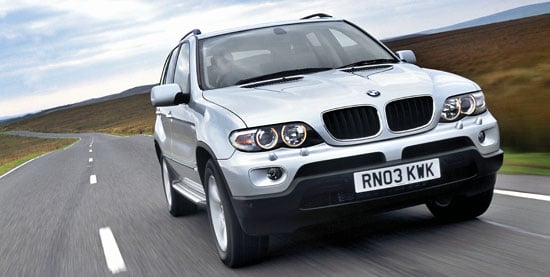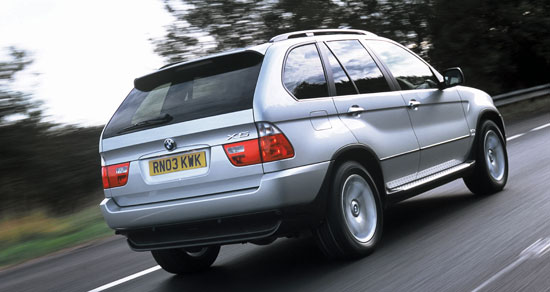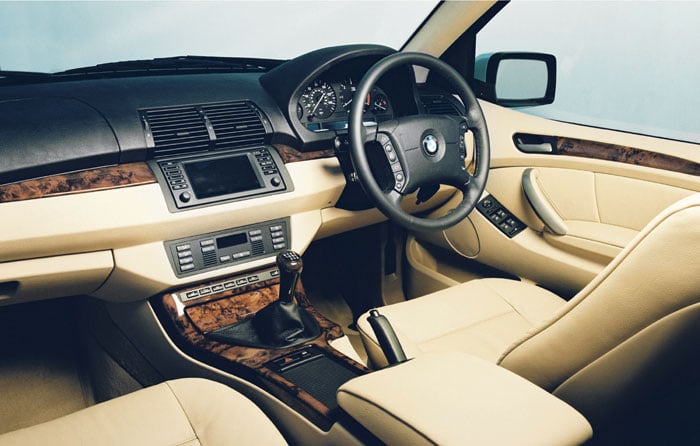Enter the new improved X5, with all-new xDrive, BMW's new 'intelligent' four-wheel drive system. This is the model that delivers it all, a car with an all-surface capability to match its stunning looks and famous on-road prowess.

But the appeal doesn't stop at intelligent four-wheel drive. A selection of new, improved engines adds to the allure, while a series of subtle design changes combine to make the best all-rounder even better.
Engines:
More power, torque, refinement and better fuel consumption come courtesy of three new engines which feature in the 3.0d, 4.4i and the forthcoming 4.8is. (The 3.0i retains the tried and tested six-cylinder unit).
Launched in April 2003 for the 730d, and recently introduced in the 530d and 330d (with lower output), the X5's new six-cylinder 3.0d engine boasts an 18 per cent increase in maximum power over the previous X5 3.0d, up from 184 to 218 bhp. The corresponding torque figure is boosted by 22 per cent to 500 Nm, the same as the outgoing M5. This high-performance diesel also claims a two second improvement in 0-62 figures with maximum speed increased to 130 mph, thanks in part to its standard six-speed gearbox, yet it still reports improvements on the combined fuel consumption cycle and CO2 figures.
The new V8 4.4i is 0.5 seconds quicker from 0-62 mph than its predecessor, achieving this in just seven seconds. Already available in the 745i and 545i, this slightly modified version offers a maximum power of 320 bhp at 6,100 rpm but, once again, fuel consumption is down - or rather up from 20.3 to 21.6 mpg. The 3.0i petrol, which retains the engine from the existing model, reports improvements in 0-62 figures and fuel consumption thanks to the inclusion of its six-speed manual gearbox as standard (compared to five-speed on the outgoing model).
The eight-cylinder X5 4.4i benefits from the introduction of a six-speed automatic gearbox, which is also available as an option on the X5 3.0d.
As for the 4.8is - all will be revealed in due course but expect it to raise the roof.

Prices:
On sale in December 2003, the new BMW X5 is priced at £34,675 on-the-road for the 3.0i SE, £35,060 for the 3.0d SE and £46,835 for the 4.4i SE.
Sport models include sports suspension, electric sports seats, sports multi-function steering wheel, anthracite headlining, Graphite line interior trim and exclusive 19" alloy wheels. Prices are £36,625 for the 3.0i Sport, £37,010 for the 3.0d Sport and £47,525 for the X5 4.4i Sport. On the current X5, Sport models account for nearly 90 per cent of sales, and demand is expected to be equally high on the new car.
The forthcoming 4.8is will enter the market in Spring 2004 priced at approximately £57,000.
xDrive:
There are two fundamental principles that underline the strengths of all-new xDrive, both on and off-road:
° Uses comprehensive vehicle data from DSC sensors to monitor road conditions and predict traction loss, enabling xDrive to act rather than react
° Improves stability, performance and safety by constantly and instantly channelling appropriate drive forces from axle-to-axle.
The benefits of this 'intelligent' four-wheel drive system? On the road, traction and agility are improved whilst over and under steer are countered during cornering; off the road, traction is significantly improved as xDrive channels drive forces to the axle with most grip rather than cutting engine power or braking troubled wheels.
The xDrive concept comprises two key ingredients - an electrically activated multiple-plate clutch which changes drive distribution from axle-to-axle, and the familiar DSC system that regulates power to each wheel. Responding in just 100 milliseconds, xDrive is far quicker than more conventional four-wheel-drive systems which rely on the build up of hydraulic pressure to channel drive forces.
Helmut Riedl, Chassis Director BMW Group commented, "xDrive is the perfect system for maximising the driving enjoyment of BMW's Sports Activity Vehicles. Through its variable distribution of drive, front-to-rear, it offers intelligent power as an antidote to loss of control, rather than braking or power reduction via DSC. xDrive keeps the fun in driving."
The intelligence of xDrive comes from Dynamic Stability Control (DSC), now standard with all new BMW cars, which delivers a wealth of vehicle data including individual wheel speed, steering angle, lateral acceleration and yaw rates. By constantly processing this information, xDrive is able to detect situations in which traction loss is likely in an instant and to transfer drive variably front-to-back the moment that grip is lost.
Naturally DSC can intervene but, because of xDrive's ability to re-direct power and prevent traction loss, it does so far less frequently and only in extreme circumstances. Where traction loss is unavoidable, DSC cuts power and, if necessary, applies brakes to individual wheels allowing the car to regain a foothold, but not necessarily slowing the car's progress.
Firm hold:
Two additional functions of Dynamic Stability Control (DSC) contribute to the exceptional safety of the new X5. Making its world debut on the new X5 is Trailer Stability Control (TSC), a system which uses yaw sensor data, applying brakes and reducing engine power if undue pendulum motion is detected in a trailer attachment. In addition Hill Descent Control (HDC) is part of the X5's standard equipment, improving off-road control by allowing drivers to travel smoothly and safely down the steepest of gradients. HDC automatically controls speed with no throttle or brake input required.
Available at speeds below 22 mph, HDC automatically reduces speed to around 5 mph. However, drivers can adjust the HDC speed between 3 and 16 mph by pressing the plus and minus keys for cruise control on the multifunction steering wheel, or using the accelerator or brake.
Fine lines:
Marrying significant enhancements to the X5 engine line-up and all-new xDrive is a series of subtle design tweaks that follows BMW design language, and makes it stand out from others that seek to imitate.
These enhancements include:
° Taller and wider kidney grilles featuring more distinctive 'wave profile' slats
° Headlamp clusters with a sweeping profile and twin corona ring sidelights
° Bi-Xenon headlamps as standard on eight cylinder models
° Re-contoured bonnet lines
° Revised colour coded air dam with separate air ducts and bumper
° Revised rear lamp cluster
° Soft close boot lid operation
BMW managing director Jim O'Donnell commented, "BMW broke the mould in off-road vehicle production when the X5 was launched in 2000. We spotted a niche in the market, which was filled by a car that balanced all the attributes of a traditional off-roader with the on-road performance typified by a BMW saloon.
"As others have followed our lead, the new improved X5 ensures further success for this premium Sports Activity Vehicle. The new model builds on the X5's enviable reputation for premium quality, performance and exceptional residuals, with far more than just a mid-life facelift. New engines, six speed gearboxes and ground-breaking new xDrive will keep the X5 at the top of its segment in the UK for many more years, proving the wisdom of targeting niches within the industry.
"Our strategy for developing premium niche vehicles continues with the forthcoming launches of models like the 6 Series and X3. Expect these to mirror the success of the X5 in the years to come."
Spartanburg plant:
The BMW X5 is built exclusively at BMW's production facility in Spartanburg, South Carolina, a plant which holds the record for the fastest production start-up in automotive history. Since opening in 1999, more than half a million cars have left the production line, initially 3 Series, then Z3 and X5s and more recently Z4 models.
Following an initial investment of $2.1bn, Spartanburg now employs more than 4,700 people in a site of 1,039 acres. It is the most automated plant in the world, using high-tech 'just-in-time' production techniques, and more than 100 robots involved in welding, transportation and quality
Components, which arrive from local suppliers, are used as and when they are needed. BMW Associates work in teams, accompanying the car through the production process, undertaking several operations before the car moves to a new team.
Cocooned in safety:
 The X5 cocoons and protects drivers and passengers like no other 4x4 thanks to a host of active and passive safety systems, which comprise BMW's F.I.R.S.T safety philosophy - Fully Integrated Road Safety Technology. This incorporates all vehicle safety systems and on the X5 can include a total of 10 airbags, including IHPS 2 (Inflatable Head Protection System) head airbags in the front and rear as standard.
The X5 cocoons and protects drivers and passengers like no other 4x4 thanks to a host of active and passive safety systems, which comprise BMW's F.I.R.S.T safety philosophy - Fully Integrated Road Safety Technology. This incorporates all vehicle safety systems and on the X5 can include a total of 10 airbags, including IHPS 2 (Inflatable Head Protection System) head airbags in the front and rear as standard.
Hill Descent Control (HDC) is a system which adds to safety and improves off-road performance by allowing drivers to select a constant speed between 3 and 16 mph for travelling safely downhill. In addition to HDC, the new X5 debuts a world first - Trailer Stability Control (TSC). This function of DSC, prevents a trailer attachment from becoming unstable, by sensing undue yaw motion, correcting speed and braking if necessary.
A maximum 5-star Euro NCAP rating for occupant protection has recently confirmed the X5's reputation as a class leader, improving on its original 4 star performance thanks to the inclusion of an intelligent seat belt occupancy sensor.
Text/Photos - BMW



